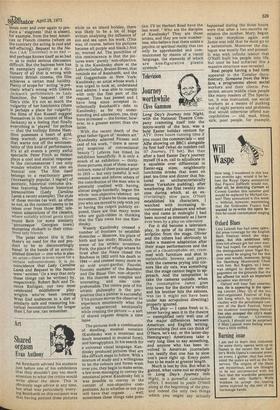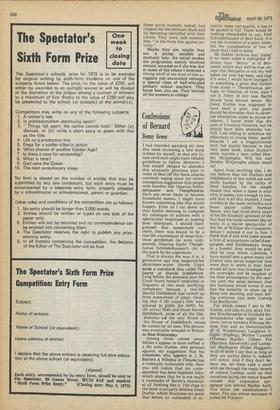Television
Journey worthwhile
Clive Gammon
Long Day's Journey into Night, with the National Theatre Company cramming itself into the micro-world of the box, was a bold Easter holiday venture for ATV: three hours running time if you count the commercials — and Alfie showing on BBC1 alongside its first half (what do insiders call it? Journey, I'll bet). But then after a hard Easter Day's journey myself (6 a.m. call to adjudicate in a squabble over differential in Easter-egg sizes; neighbourly lunchtime drinks that went on past tea-time and dinner that featured an uncharacterisically dense Yorkshire pudding), after weathering the first twenty minutes . during which, at an excruciatingly slow pace. O'Neill established his characters, I watched with increasing involvement and pleasure and when the end came at midnight I had been moved as intensely as I have ever been by a play on television.
For it did become a television play, in spite of its direct tran scription from the stage. Olivier and the others had obviously to make a massive adaptation after their stage performances and the use of a claustrophobic set, cram med with furniture and shot in melancholic browns and greys, with the cameras prying into cor ners like sly cats, was something that the stage cannot begin to ap proach. And the temptation to take the cameras outside, when the consumptive Jamie goes into town for the doctor's verdict and his brother hits the saloons, was (as it might not have been under less scrupulous directing) properly ignored.
This play — I came fresh to it, never having seen it in the theatre — exemplified very well one of the major differences between American and English writing. Generalising (but one can think of O'Hara, let's say, or the latter-day Hemingway) Americans take a very long time to say something, and anyone who has been involved in American journalism can testify that one has to slow one's pace right up. Every point has to be made at greater length.
Much is lost by this. But what is gained, what came out so strongly in Long Day's Journey into Night, is a powerful cumulative effect. 1 wanted to jostle O'Neill along at the beginning of the play, and indeed the only two things which you might say actually happened during the three hours were that after a two-months remission the mother, Mary, began to take morphine again and Jamie was told that he must go to a sanatorium. Moreover the dialogue was mostly flat and prosaic. It was with infinite labour that O'Neill built his people into life, but once he had achieved this a massive structure was revealed.
Real people having a bad time appeared in the Tuesday documentary, Someone from the Welfare, a programme about social workers and their clients. Protected, secure middle class people like many readers of The Spectator, it was insinuated, use social workers as a means of pushing out of sight persons and problems that would otherwise offend susceptibilities — old, mad, blind, sick, poor people, for example,
Some social workers, indeed, had crossed the line between them and us, becoming identified with their clients. They were, said someone else," in the front line against poverty."
Maybe they are, maybe they are. A plump, sensible and motherly lady, the social worker the programme mainly revolved around, sounded as if she was. But in some of the others I detected a strong whiff of the kind of dim arrogance one encounters amongst a special class of half-educated primary school teachers. They know best, you see. They learned all the answers in college.



































 Previous page
Previous page